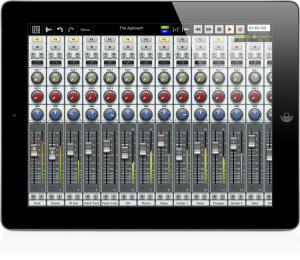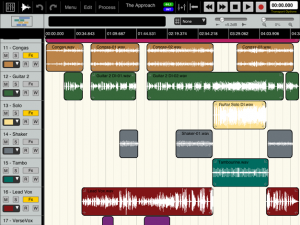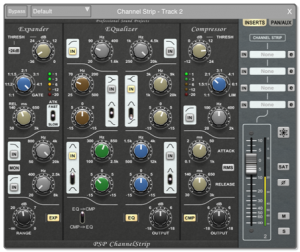Review: Auria DAW for iPad – by Eli Janney
OK, let’s get this out of the way right at the top: yes, it actually works, and yes, it actually sounds good. Those are the two biggest questions I’ve been asked while writing this review, and admittedly my own biggest questions as well.
If you’re just tuning in, the Auria app from Wavemachine Labs is a 48-track full featured DAW for iPad. And by full-featured (usually a marketing phrase that means “missing some stuff”) I mean it has everything you would need to record, edit and mix a moderately sized project. It can handle up to 48 tracks of stereo or mono files in playback, and record 24 tracks at once if you have the right interface.
It’s got plugins (including it’s own plugin store!), delay compensation, AAF import and export, WIST syncing (you can actually have two iPads work together), adjustable metering, adjustable pan laws (very cool and nerdy), 8 subgroups, two aux sends and returns and a bunch of other cool things.
Basically it’s got everything you would expect in a basic DAW, plus some things you wouldn’t expect, like the pan law adjustment. All this on an iPad! It’s kind of mindblowing, and definitely feels like we’ve entered a new era in recording.
But the iPad itself has some pretty big limitations, and the usefulness of the app depends on how well you can deal with those limitations.
Every channel gets one
As far as features go, Wavemachine definitely tried to cover all the ground. Every channel has a built in channel strip, created by PSP Audioware. If you don’t know this company, you should, the make really great plugins at very reasonable prices. Based in Poland, these guys make the Vintagewarmer mix compressor/saturator and the Nitro, a fairly incomprehensible chorus/filter/delay plugin that is amazing.
The channel strip they came up with is great: It includes an Expander/Gate, EQ with filters, and a compressor. It has a great selection of Q switches and Attack/Release, giving you the right amount of control without overburdening the layout. Each module within the strip can be switched on and off, reducing the processor load, and the order of EQ and compressor can be switched around. It sounds good and works without surprises.
This is also where you can insert plugins, each channel strip has four slots to drop in plugins (which are post channelstrip), and there’s a saturation switch on the output. The saturation switch has no controls — the manual says it adds harmonics when pushed to emulate analog hardware. In use it sounds pretty decent, but I didn’t end up using it much since I didn’t have any control over it. It was actually easier to make it sound warm using the master channel strip.
The master channel strip is slightly different, with a very simple EQ and more extensive Compressor (here called the Busspressor) but with the same limiter. It also has the four plugin slots, post strip. I should say here that this same Masterstrip is on each of the eight subgroups, so you can go really overkill on the compression, which I’m sure NOBODY will do in this day and age (ha). The mix window can be used in landscape or portrait mode, so the faders get nice and long for fine mixing.
And A Bag Of Chips
There’s another big feature for us Pro Tools users. Everybody else already has this, but the app actually does Freeze to lower the CPU usage. It’s such an amazing thing, and again points to how lame it is in this day and age that Pro Tools doesn’t have this great feature. Each channelstrip has a snowflake-looking button that writes all the current plugins to the track and disables the real-time processing, thereby saving the strain on the iPad’s meager processor. Awesome.
The editing window is where it gets a bit tricky. There’s actually nothing wrong with their implementation, you use multitouch gestures to zoom in and out, and to make edits. It’s pretty slick and it works well.
Except there are two large problems: editing with your fingers is imprecise at best and the iPad screen is only 9.7 inches. I mean, would you ever buy a 10” monitor to do audio work? It’s crazy! You end up doing A LOT of zooming in and out to see what you’re doing. And then trying to edit something while your finger is covering it is kind of a recipe for frustration.
Neither of these problems are Wavemachine’s fault at all, I realize that, and what they’ve accomplished with this app is nothing short of amazing, but you will never escape those two rather large issues. I found recording on it to work great, editing not so much.
Are We Rolling?
Speaking of recording I used the Auria app with my Lynx Aurora 16 and it worked wonderfully for recording. It’s a bit odd to hook it up — the iPad thinks the Aurora needs power, which it clearly doesn’t, so the interface must first be plugged into a powered USB hub and then into the iPad via a camera connection kit. It looks pretty Frankensteined together in use, but it actually works!
You have to first create tracks and then set the input via the Input Matrix. It was pretty cool to have all those inputs available. Unfortunately, you can only have two outputs at a time so no summing outside the box.
When you are finally ready to mix, you select “mixdown” and the app creates a mix from the start and end points you’ve selected. This mix is not run in realtime, it goes as fast as the CPU can run it, similar to Live and other DAWs. In the “mixdown” window you can select to send the mix directly to Dropbox or Soundcloud, which is really cool: You enter your Dropbox login, and the app will create an Auria folder on your dropbox and automatically upload it to that location.
This addresses what is possibly the biggest problem with the app, and has nothing to do with Wavemachine: the iOS file handling system. If you’ve ever tried to get things on and off an iPad, you know what a bitch it can be. You have to physically plug it in to your computer, launch iTunes, go to the info window of your iPad within iTunes, find the app you want to work with, and then add or move the file from there.
Not exactly smooth. And definitely not something you want to do every time you want to change songs. So the ability to export to Dropbox and Soundcloud is an absolute necessity. This only addresses the exporting of songs and mixes, not the importing, but it’s better than nothing.
What’cha Want, Anyway?
Wavemachine’s Auria is absolutely the most well-thought-out and finished first release of a DAW I’ve seen on any platform, and to accomplish all that on an iPad is truly a work of art.
The app’s usefulness as a demo machine to replace your Tascam Portastudio is basically a no-brainer. It’s doesn’t have built-in instruments, but it does have pretty much everything else you need to make a record in your bedroom.
To consider it as an alternative to a laptop DAW you really need to understand the limitations of the iPad or you will get frustrated, but for $50 there is no competition.
— Eli Janney
Please note: When you buy products through links on this page, we may earn an affiliate commission.










Lenfantbleu
October 11, 2012 at 1:53 pm (13 years ago)Good review — I’m using it with the Apogee Mic thingy, and man, you can track anywhere with that set-up.
Dillon
December 25, 2012 at 3:46 pm (12 years ago)Can you make dubstep with it? I currently use Nanostudio on my iPad and I’m very impressed with how you can make your own synths. Does this app have side chaining capabilities? Please reply to my comment at my email dtleen@gmail.com. Really wanna know before I pay $50 for something I’m not gonna use.
Smurky
February 18, 2013 at 9:22 am (12 years ago)A stylus can be very helpful for editing.
Marco
September 7, 2013 at 9:36 am (12 years ago)Hi, i play music for many years and record as well, being used to Cubasis I unfortunately spent money on Auria and trouble came. I can not agree that Auria is a recording studio Audiobus compatible because it crashes after five minutes use every twice recordings. I lost an entire 18 minutes live recording because Auria frooze and crashed one time too much. Worse is that when I contacted WaveMachine, they ADMiTTED the trouble saying Auria like any other software is crashing yes, and that if I want to be reimbursed, I just have to contact Apple. Woaw, for a so called professional studio. They even deleted my comment on their Facebook wall asking about crashes, to be sure nobody reads from someone who is more then an occasional player (I made 4 albums under a small UK label) I go back to Cubasis, too much hype around Auria and if people buy Auria for effects, be my guest but I won’t invest one usd more in a company treating indie musicians like that. They probably behave differently with Lady Gaga ….